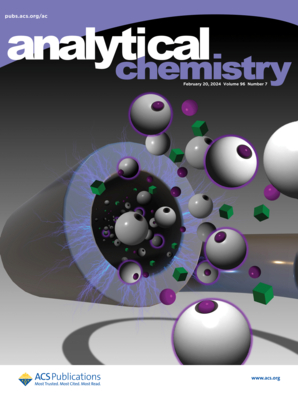通过扩展悬臂控制杂交链反应深度及其分析应用
IF 6.7
1区 化学
Q1 CHEMISTRY, ANALYTICAL
引用次数: 0
摘要
杂交链反应(HCR)是一种强大的无酶核酸扩增策略。在启动子链的触发下,它产生类似于交替共聚物的切口双螺旋。然而,目前还没有有效的方法来调控 HCR 反应,最明显的现象是引入引发剂后产物的聚合无法控制。在此,我们探讨了通过延长发夹单体上的悬垂末端来控制 HCR 反应的深度,并报告了序列长度、核苷酸组成和二级结构可改变 HCR 聚合,并可用于所需的调节。用 oxDNA 模拟的引发剂和发夹单体之间的相互作用动力学与实验结果非常吻合。这种调控效果可用于 HCR 以前无法实现的新的分析应用,如分析链延伸酶和识别短序列结构。这一发现为控制 HCR 反应的深度提供了一种简洁而有效的方法,并将 HCR 的应用范围拓展到更多领域。本文章由计算机程序翻译,如有差异,请以英文原文为准。

Controlling the Depth of Hybridization Chain Reaction by Extended Dangling Ends and Its Analytical Applications
Hybridization chain reaction (HCR) is a powerful enzyme-free nucleic acid amplification strategy. Triggered by an initiator strand, it yields nicked double helices analogous to alternating copolymers. However, there is no effective way to regulate the HCR reaction, and the most apparent phenomenon is the uncontrollable polymerization of product after introducing an initiator. Here we explore controlling the depth of the HCR reaction by extended dangling ends on hairpin monomers and report that sequence length, nucleotide composition, and secondary structure can alter HCR polymerization and can be utilized for the desired regulation. Interaction dynamics between initiator and hairpin monomers simulated by oxDNA are in good accordance with experimental results. Such a controlling effect can be utilized for new analytical applications that HCR cannot previously achieve, such as analyzing strand-extension enzymes and identifying short-sequence structures. The finding provides a concise but effective way for controlling the depth of HCR reaction and opens the application scope of HCR to more fields.
求助全文
通过发布文献求助,成功后即可免费获取论文全文。
去求助
来源期刊

Analytical Chemistry
化学-分析化学
CiteScore
12.10
自引率
12.20%
发文量
1949
审稿时长
1.4 months
期刊介绍:
Analytical Chemistry, a peer-reviewed research journal, focuses on disseminating new and original knowledge across all branches of analytical chemistry. Fundamental articles may explore general principles of chemical measurement science and need not directly address existing or potential analytical methodology. They can be entirely theoretical or report experimental results. Contributions may cover various phases of analytical operations, including sampling, bioanalysis, electrochemistry, mass spectrometry, microscale and nanoscale systems, environmental analysis, separations, spectroscopy, chemical reactions and selectivity, instrumentation, imaging, surface analysis, and data processing. Papers discussing known analytical methods should present a significant, original application of the method, a notable improvement, or results on an important analyte.
 求助内容:
求助内容: 应助结果提醒方式:
应助结果提醒方式:


